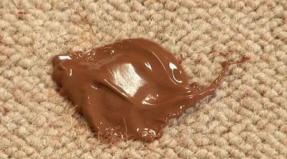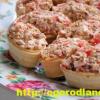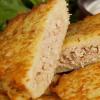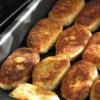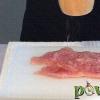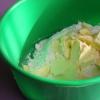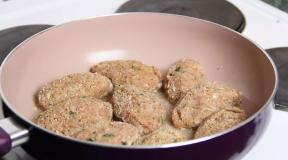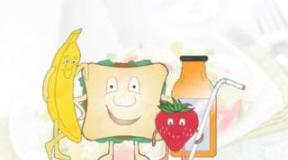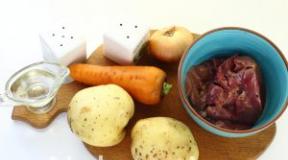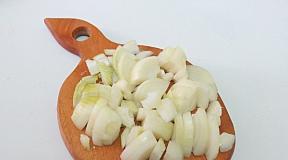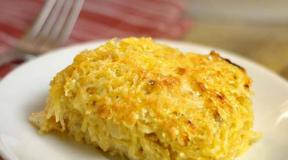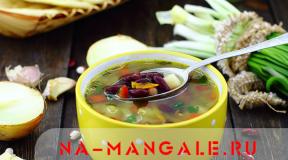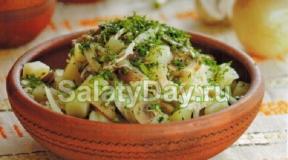Spring larks made from yeast dough. Dough larks

Let's call Spring together! Let's all bake larks together! These cute birds are true messengers of Spring, sun and warmth! And if the whole world bakes many, many warm, rosy buns in the form of larks - Spring will finally come
F.I. Tyutchev
Winter is not without reason angry
Its time has passed -
Spring is knocking on the window
And drives them out of the yard.
And everything was in a fuss
Everything is boring Winter out -
And the larks in the sky
They have already raised the ringing bell.
Winter is still busy
And grumbles at Spring.
She laughs in her eyes
And it only makes more noise ...
The wicked witch went berserk
And, capturing the snow,
She let go, running away
Into a beautiful child ...
Spring and grief is not enough:
I washed myself in the snow
And only became blush
Contrary to the enemy.
I've heard a lot about baking a lark, but I baked it for the first time. And I will tell you what a fascinating and enjoyable business it is! Children will be especially happy, just let them pour the dough. True, not always larks are obtained, but sausages, pies, koloboks, suns - but how much pleasure!
I found how to sculpt larks. And we will make the dough lean yeast, like for pizza or donuts, only more sugar.

Ingredients for Lean Yeast Lark Batter:
- 5.5 glasses of wheat flour and another half a glass to sprinkle on the table, only about 1 kg of flour;
- 2 glasses of warm water;
- 30 g fresh yeast;
- 3 tablespoons of sugar;
- 3 tablespoons of sunflower oil;
- raisins - a smaller, darker shade is better suited for the eye, it is more similar than large light, amber raisins.
How to bake larks:
Knead the dough.

Chop the yeast into a bowl, grind with sugar until liquid, pour in 1 glass of warm water, stir.

Sift 1.5 cups of flour, knead the dough and put in a warm water bath for half an hour.



Gently mix the matched dough, add the remaining glass of warm water and gradually, sifting, stir the flour - I added 4 glasses one by one. At the end of kneading, pour in the sunflower oil.

It turns out a dense dough, a little steeper than usual for pies, so the larks will keep their shape well. Sprinkle flour on the table and knead the dough well so that it becomes homogeneous and smooth. Then sprinkle with flour on all sides so that it does not dry out and stick to the bowl, and again put it in a water bath for 20 minutes.
Now the fun part - it's time to sculpt larks!
We tried 3 ways. I liked the first one the most. When we were making the second batch, it became so easy and great to get it! The dough ended here

Making a sausage.

We tie this sausage into a knot.

At one end we make a round head with a beak, cut the other with a knife, we get a fan - this is a tail.

We insert the eyes from the raisins. Stick them deeper so they don't fall out when the dough comes up.


We put the larks on a baking sheet for proofing. As long as you blind everyone, they will do just fine. I do this: I turn on the oven on a small light, and put the baking sheet. Top of the stove. And the oven is warming up, and the buns are warm.
Second way.

We also roll up the sausage, but do not tie it, but simply fold it in the form of a loop.

The loop itself is the head, the tips are the wings. Fan-cut the feathers, make eyes.


Third way. We make a cake, on the one hand it is narrow, on the other it expands.

On a narrow tip we make a beak and eyes, and a wide one, slightly pressing, cut into two - a tail and a wing.

We cut the "feathers" on the tail and wing, bend the wing up.



We spread the larks on a baking sheet, not very close to each other, the distance between them should be at least 5-7 cm so that the baked goods that have come up do not stick together.

Sprinkle the larks with sugar and put them in a warm oven and bake at 180-200 (depending on how it fits), I baked for 45 minutes.

Ready-made larks are very beautiful! Golden, and you take it in your hands - warm! This is how spring feels!

Stove on Soroki - the day of the vernal equinox - buns in the form of birds, invoking spring with them - an ancient pagan tradition of the Slavic farmers. At least that's what ethnographers say. 🙂 Christianity accepted this holiday, giving it the name Soroca (in honor of the forty great martyrs), but demanded a reciprocal concession. No matter how the terms of Orthodox Easter change, March 22 invariably falls in the midst of Great Lent, and therefore larks from the dough, this traditional ritual or, of course, must be lean.
Today we will bake larks from lean yeast dough in accordance with all the canons of Lenten. My detailed, step-by-step photo recipe will outline the preparation exactly as our grandmothers have done for a long time - without eggs, milk and other muffins.
For lean yeast dough, we will only use:
- water 250 ml;
- flour 500 gr;
- vegetable oil 2-2.5 tbsp;
- sugar 2-3 tablespoons;
- salt 1 tsp without a slide;
- yeast 1.5 tsp dry or 25 grams fresh.
As a flavoring agent, you can take vanillin, cinnamon, cardamom, ginger - whatever you like.
How to bake dough larks
To make the dough larks, in fact lean buns, come up faster and turn out to be more fluffy, you can first put a dough of half the flour, the norm of water and sugar. We'll add the rest of the ingredients later and let the dough rise well a couple of times.
Knead the finished lean yeast dough well and divide into 2-4 parts.

While we are carving the first quarter of the dough, wrap the rest of the pieces in foil or simply cover with a napkin.

Divide a piece of dough into 4 or 6 equal pieces. It is very easy to mold our birds from such small pieces.

First you need to make a "sausage", for which we roll out a piece of dough to the desired length.


Flatten the lower tip of the dough on the table and cut it - this will be the tail. We make a head from the top: we sculpt a sharp beak, insert raisins instead of a peephole. If the raisins are large, you can cut each berry into 2-4 pieces. The simplest lark is ready.

But even lean pastries can be made tasty and sweet, as the main characters of this spring holiday, children, love. Roll a piece of dough into a cake, grease with vegetable oil and sprinkle with sugar.

We roll up the cake with a tight roll, which we tie in a knot and form a lark.

To make the dough larks more beautiful and perky, you can make notches with kitchen scissors - "ruffle the feathers", or sprinkle the backs with sugar, poppy seeds, sesame seeds or seeds.

Lean baked goods cannot be greased with eggs or milk, but strong sweet tea will help us to make the larks ruddy, with which we grease them before baking.

You need to bake such pastries in the oven at 180-200 degrees, until a beautiful brownish color, 15-20 minutes.

Unusual and delicious lean buns in the shape of birds can be baked not only on the spring equinox, but also in any other case, when you want something sweet, but lean.
Let's call Spring together! Let's all bake larks together! These cute birds are true messengers of Spring, sun and warmth! And if the whole world bakes many, many warm, rosy buns in the shape of larks - Spring will finally come!
For what holiday are dough larks baked? According to the Orthodox calendar, March 22 is the Memorial Day of the Forty Martyrs of Sebastia. Also on this day, an old Slavic holiday was celebrated - Larks. It was believed that on this day these little songbirds flew in, and after them spring came.
We are already tired of winter, together with its cold and icy conditions, so we decided to invite a warm sunny spring and bake rich larks.
Butcher dough is made for larks. Do not forget that it is Great Lent, so the dough will be lean. By the way, I like butter dough on water and vegetable oil more than on milk and eggs.
For those who decide to bake larks according to our recipe, we will reveal our secrets of their preparation. Sparkling mineral water is used for the dough, so the dough rises a lot - make the larks not too large and put them on a baking sheet away from each other. To keep the birds beautiful and ruddy, brush them with a strong sweet brew before baking. After baking, you can grease the larks with vegetable oil.
Well, that's all the secrets of making larks. As you can see, there are not many of them, and the process itself is simple and fun. Let's celebrate spring with fun and deliciousness!
- Flour - 0.5 kg.;
- Carbonated water - 200 ml;
- Vegetable oil - 75 grams;
- Sugar - 3 tablespoons;
- Salt - 1 teaspoon;
- Yeast - 1 sachet (11 grams);
- Strong sweet tea - 2-3 tablespoons;
- Raisins for the eyes.

Dissolve yeast in warm carbonated water.
Sift flour into a deep bowl, add sugar, salt, vegetable oil, water with yeast and knead the dough.
Cover the bowl with the dough with a clean towel and put it in a warm place for 1 hour.
When the dough rises, knead it and make larks. We make larks like this - we divide the dough into 15 equal parts, roll each ball of dough into a rope and tie it with a knot, form a head from one end of the knot, and flatten the other end and cut it in the form of a tail.

There is another way to make dough larks:

This is how we bake dough larks:

Before baking, grease the larks with strong sweet tea.
We bake larks in a preheated oven at a temperature of 220-240 degrees for 15 minutes.
Ready-made larks can be greased with vegetable oil.

Recipe 2, step by step: lean dough larks
Oven on Soroki - the day of the vernal equinox - buns in the form of birds, invoking spring with them - an ancient pagan tradition of the Slavic farmers. At least that's what ethnographers say. Christianity accepted this holiday, giving it the name Soroca (in honor of the forty great martyrs), but demanded a reciprocal concession. No matter how the dates of Orthodox Easter change, March 22 invariably falls in the midst of Great Lent, and therefore dough larks, this traditional ritual or ceremonial baking, must certainly be lean.
Today we will bake larks from lean yeast dough in accordance with all the canons of Lenten. My detailed, step-by-step photo recipe will outline the preparation exactly as our grandmothers have done for a long time - without eggs, milk and other muffins.
- water 250 ml;
- flour 500 gr;
- vegetable oil 2-2.5 tbsp;
- sugar 2-3 tablespoons;
- salt 1 tsp without a slide;
- yeast 1.5 tsp dry or 25 grams fresh.
As a flavoring agent, you can take vanillin, cinnamon, cardamom, ginger - whatever you like.

To make the dough larks, in fact lean buns, come up faster and turn out to be more fluffy, you can first put a dough of half the flour, the norm of water and sugar. We'll add the rest of the ingredients later and let the dough rise well a couple of times.

Knead the finished lean yeast dough well and divide into 2-4 parts.

While we are carving the first quarter of the dough, wrap the rest of the pieces in foil or simply cover with a napkin.

Divide a piece of dough into 4 or 6 equal pieces. It is very easy to mold our birds from such small pieces.

First you need to make a "sausage", for which we roll out a piece of dough to the desired length.


Flatten the lower tip of the dough on the table and cut it - this will be the tail. We make a head from the top: we sculpt a sharp beak, insert raisins instead of a peephole. If the raisins are large, you can cut each berry into 2-4 pieces. The simplest lark is ready.

But even lean pastries can be made tasty and sweet, as the main characters of this spring holiday, children, love. Roll a piece of dough into a cake, grease with vegetable oil and sprinkle with sugar.

We roll up the cake with a tight roll, which we tie in a knot and form a lark.

To make the dough larks more beautiful and perky, you can make notches with kitchen scissors - "ruffle the feathers", or sprinkle the backs with sugar, poppy seeds, sesame seeds or seeds.

Lean baked goods cannot be greased with eggs or milk, but strong sweet tea will help us to make the larks ruddy, with which we grease them before baking.
You need to bake such pastries in the oven at 180-200 degrees, until a beautiful brownish color, 15-20 minutes.
Unusual and delicious lean buns in the shape of birds can be baked not only on the spring equinox, but also in any other case, when you want something sweet, but lean.

Recipe 3: how to bake dough larks (with photo)
- Active dry yeast - 7 g
- Sugar (sand) - 110 g
- Wheat flour - 470 g
- Salt - 1 tsp
- Vegetable oil - 75 ml
- Dark raisins - 20 g
To begin with, we put a liquid dough. Dilute yeast in a glass of warm water (200 ml), add 3 teaspoons of sugar and half a glass of flour. Knead and leave to stand until it rises.
Add 5 tablespoons of vegetable oil, ¼ glass of sugar, a teaspoon of salt to the dough, then add flour, about 3 cups, knead, if the dough is sticky, then add flour until the dough becomes tight enough, it should move well from hands. Knead and leave to come up, then mix again.
Divide the dough into portions.
And we make larks. How to make a lark out of dough? For example like this. Roll out a portion of the dough into a sausage:
We turn off.
We twist the muzzle.
Flatten the tail and use a knife to make feathers, insert raisin eyes.
And you can sculpt dough larks like that. Divide the sausage in half.
We put it crosswise.
We form the wings, tail and head.
We decorate the feathers and eyes.
Or you can take a piece of dough and make it flat at one end.
Divide in half.
And we throw the bottom piece up - a wing. We decorate the head, feathers, insert the eye.
We plant the birds on a baking sheet. I do not upset them, because while I mold them, they manage to distance themselves. Lubricate with sugar water (I diluted 3-4 teaspoons of sugar per 100 grams of water)
And we send it to the oven, preheated to 180-200 degrees. We bake until browning, take out, grease again with sugar water, cover with a towel and let cool. Happy holiday!
Recipe 4: spring buns Skylark dough
Incredibly delicious dough, lean and easy to prepare! Larks rolls are simply magical. Today we will try two types of sculpting. We bake "larks" - we call and wait for spring!
- Flour - 420-470 g
- Pressed yeast - 20 g
- Water - 1 glass
- Sugar - 100 g
- Salt - ½ teaspoon
- Vanilla sugar - 1 tbsp spoon
- Vegetable oil - 50-70 ml
- Raisins - for decoration
- Sweet black tea - for greasing buns

We prepare products for buns.

How to make Larks buns from lean yeast dough: warm water, 2 tbsp. l. sugar, 2 tbsp. l. flour and yeast, prepare the dough.

Cover with plastic wrap and let stand for 10 minutes.

When the yeast rises with a "hat", you can cook the dough further.

Add salt and sugar to the flour. We mix.

Add dough, vegetable oil.

Knead the dough - it should be thick enough. (I added another 50 g flour as the dough didn't seem thick enough to me.)

We round off the dough, send it to a plate, cover with foil and let it stand in a warm place for 40-60 minutes. The dough should double in size.

Knead the dough well for a couple of minutes. Divide the dough into portions of 65-70 g.

We roll out the bundles about 20 cm. The middle of the bundle should be thicker.

We tie the tourniquet into a knot, forming one "lark". Straighten the "tail" and make cuts with a knife, form a "beak", cut the raisins into 4 parts and make "eyes".

To form double larks, cross two bundles.

We thread the ends of one bundle inside the second. We form "beaks".

We make the "eyes" from the raisins, form the "tail" with a fork.

To make the "beaks" look even more natural, we cut them with scissors.

Let the yeast dough buns stand for 10-15 minutes.

Lubricate the buns with strong sweet tea and bake at 180-200 degrees until tender.

Homemade Larks buns are ready. Every year, on March 22, we bake these buns and bring spring closer.

Bon Appetit!

Recipe 5: spring birds from the lark dough
A simple, lean, budgetary, versatile version of dough for buns and pies and the traditional version of molding dough birds. Step by step recipe.
- Wheat flour / Flour - 1 kg
- Salt - 1 tsp
- Sugar (granulated sugar) - 1.5 tbsp. l.
- Yeast (dry) - 10 g
- Water (boiled, room temperature) - 0.5 l

Sift the flour through a sieve.

Combine dry ingredients (flour, salt, sugar, yeast) together.

Mix well.

Pour water into a wide, high container.

Gradually pour the dry mixture into the water, stirring first with a spoon, then with your hands. In a bowl, knead the tough dough well.

Cover with a towel. Put in a warm place for 40 minutes.

Knead the risen dough.

Divide into two equal parts. Leave one part for work. Cover the second with a towel again so that it does not get windy.

Roll out the sausage from the left dough. Cut it into equal parts.

Roll out a rope about 15 cm long from each small piece of dough.

Form the birds by tying the tourniquet in a knot. For the eyes of our bird, buckwheat grains may be suitable.

Place the birds on a baking sheet covered with foil, give the dough a little rest.

Brew strong tea, dilute sugar in it. Brush the heads, backs and tails of our birds.

We put the baking sheet in the oven heated to 180 degrees. We watch when the crust is browned on the buns.

The baking time depends on the size of the baked goods and the characteristics of your oven. We take the second part of the test to work. We repeat in the same order. Bon Appetit!

Recipe 6, simple: how to make larks out of dough
- 1 glass of water
- 0.5 cups flour
- 3 tsp sugar
- 7 g dry yeast
- ¼ glasses of sugar,
- 1 tsp salt
- 5 tablespoons of vegetable oil,
- 3 ~ 3.5 cups flour

Dissolve yeast in warm water and stir in sugar and flour. Put in a warm place until the dough is 2 ~ 3 times larger.

Put sugar, salt in the dough, pour in vegetable oil and add 2.5 cups of flour. Mix. Pour half a glass of flour on the table, pour the dough onto the flour. Knead, adding a little flour, until the dough is smooth, homogeneous, moist, but not sticky to your hands. (From these products you will get about 870g of dough.) Cover the dough with cling film and leave to rise. When the dough has increased by 1.5 ~ 2 times, cut it into equal pieces, which then roll into balls. Larks are molded in many different ways.
Sitting lark. Roll the dough ball into a long sausage. (photo 1) Tie the sausage with a knot. (photo 2) At the end, which turned out to be at the top, pull out the nose and insert the eye-raisin. The second - the lower - flatten the end with your fingers and cut, which will indicate the feathers on the tail. (photo 3)

Flying lark (option 1). Roll the dough ball into a short thick sausage. (photo 1) At one end, extend the beak and insert the eye.
At the other end, flatten out 2/3 of the sausage length with your fingers or roll it out. When rolling, you need to stretch the dough in width, not in length.
In the middle of the rolled part, along the roller, make a cut. (photo 2) Then cut both the resulting halves with shorter cuts. Lift one part and lay it on top of the other, so that these parts are perpendicular to each other. (Photo 3)

Flying lark (option 2). Pinch off a small piece from a ball of dough. Roll it into a thin circle and cut half of the circle into a fringe. Roll a large ball into a roller, pull off the beak on one side and insert an eye. Flatten and cut the other end a little. (photo 1) A small circle - a wing - moisten on one side with water and put on the body blank, cut side up. (photo 2)

You can make the larks taste more interesting. To do this, roll a ball of dough into a not very large cake. This tortilla can either be greased with vegetable oil and sprinkled with sugar, or sprinkled with poppy seeds or crushed nuts, or spread with chopped dried fruits or grated apples. Then roll the cake into a roll (photo 1). After that, the lark is formed according to the first method of the flying lark (photo 2, 3, 4).

Place the sculpted items on a greased baking sheet or lined with baking paper. Brush with sweet water and bake until browning at t = 180 ~ 200 ° C. Grease the finished larks, without removing from the baking sheet, with sweet water or vegetable oil, cover with a towel and leave to cool.

Recipe 7: baking Larks with an apple on March 22
The shape of the birds can be given in different ways. I use the "knot" most often. I roll part of the dough with my palms into a plump flagellum and twist it in a knot. In order to make it a lark, three strokes are enough: on the head (upper tip of the knot), pull out the nose, insert raisin eyes on both sides of it, and make two cuts on the tail (the lower end of the knot).
- warm water - 700 ml
- dry yeast - 11 g (or 50 g live)
- wheat flour, premium quality - 1250 g
- sunflower oil - 6 tablespoons
- apple - 1 piece
- sugar - 1 tablespoon
- salt - 1 tsp
- turmeric - 1 tsp
- raisins - a handful

Do you remember what larks look like? They are brown in color, often with a yellowish tint. And sometimes a well-defined yellow breast or muzzle. To make the dough larks have a similar color, I added turmeric to the dough.
And yet, I introduced one of my own ideas into this recipe - I mixed a grated apple into the dough. I did this so that the lean dough was soft and not dry. Of course, there is no apple taste in the buns and cannot be, but there is tenderness, as I planned!
I sifted 600 grams of flour into a large deep bowl.

Dry yeast, turmeric, salt and sugar were poured into it. If you want to use live yeast, then dissolve it in water and enter in the next step. If desired, the amount of sugar can be increased up to 200 g.

Thoroughly mixed all dry ingredients for even distribution. She poured in warm water (all at once - 700 ml).

She stirred the dough and left it just on the table, covering the dishes with a lid, for about an hour.

During this time, the dough rose magnificently and bubbled!

I washed the large apple, cut off the peel from it, and rubbed the flesh coarsely. Added to the dough.

Stir and then sift the remaining flour (600-650 g).

At the end, while kneading, I poured in sunflower oil (this time I took refined oil).

I rolled the dough into a ball. It should not be too dense - you should not clog it with flour. Better to let it stick to your hands a little (but just a little).

She covered it with a lid again and left it on the table. The dough rose quickly, in about 40 minutes. I kneaded it and let it rise again (it took about the same amount of time).

For convenience, the dough was divided into 4 parts. And then I cut each of them into 10 approximately equal ones. I always bake exactly 40 larks - according to the number of the Holy Martyrs of Sebastia. I do this even if I make the batch not from 1250 grams of flour, as it is now, but from 500-600 grams. It's just that in the second case, the birds turn out to be small. And in today's version they are medium in size.

I formed a tourniquet from each part of the dough with my palms.

With a simple movement, she folded it into a bundle.

Here's what happened:

From the upper free end of the knot, she formed a head, slightly stretched out the nose. On the sides I inserted eyes from halves and quarters (depending on the size) of raisins. So that the raisins do not fall out during the baking process or after, before inserting it, I slightly press the grooves on both sides of the spout with a small knife. Then I insert a piece of raisins (a whole one is not needed, even if a small one will fall out) and again press it into the depths with a knife.

The second (lower) free end of the knot was stretched out a little and cut in two places, as if dividing the feathers.

She formed all 40 birds by the same principle. Baked on foil (you can do without it), greased with sunflower oil, 10 pieces on a baking sheet.

Birds take 25 minutes in the oven at 180-200 "C.

Let the larks cool completely. I smeared it with sunflower oil on top and put it on a dish.
So that is all! Festive, yellow, light and tasty larks are ready!

Recipe 8: holiday larks - baking options
- 5.5 cups of wheat flour and another half a glass to sprinkle on the table, only about 1 kg of flour;
- 2 glasses of warm water;
- 30 g fresh yeast;
- 3 tablespoons of sugar;
- 3 tablespoons of sunflower oil;
- raisins - a smaller, darker shade is better suited for the eye, it is more similar than large light, amber raisins.

Knead the dough.

Chop the yeast into a bowl, grind with sugar until liquid, pour in 1 glass of warm water, stir.

Sift 1.5 cups of flour.

Knead the dough and put it in a warm water bath for half an hour.

Gently mix the matched dough, add the remaining glass of warm water and gradually, sifting, stir the flour - I added 4 glasses one at a time. At the end of kneading, pour in the sunflower oil.

It turns out a dense dough, a little steeper than usual for pies, so the larks will keep their shape well. Sprinkle flour on the table and knead the dough well so that it becomes homogeneous and smooth. Then sprinkle with flour on all sides so that it does not dry out and stick to the bowl, and again put it in a water bath for 20 minutes.
Now the fun part - it's time to sculpt larks!
We tried 3 ways. I liked the first one the most. When we were making the second batch, it became so easy and great to get it! Then the dough ended.
Making a sausage.

We tie this sausage into a knot.

At one end we make a round head with a beak, cut the other with a knife, and we get a fan - this is a tail.

We insert the eyes from the raisins. Stick them deeper so they don't fall out when the dough comes up.

We put the larks on a baking sheet for proofing. As long as you blind everyone, they will do just fine. I do this: I turn on the oven on a small light, and put the baking sheet on top of the stove. And the oven is warming up, and the buns are warm.

Second way.

We also roll up the sausage, but do not tie it, but simply fold it in the form of a loop.

The loop itself is the head, the tips are the wings. Fan-cut the feathers, make eyes.

Third way. We make a cake, on the one hand it is narrow, on the other it expands.

On a narrow tip we make a beak and eyes, and a wide one, slightly pressing, cut into two - a tail and a wing.

We cut the "feathers" on the tail and wing, bend the wing up.

We spread the larks on a baking sheet, not very close to each other, the distance between them should be at least 5-7 cm so that the baked goods that have come up do not stick together.

Sprinkle the larks with sugar, put them in a warm oven and bake at 180-200 (depending on how it fits), I baked for 45 minutes.

Ready-made larks are very beautiful! Golden, and you take it in your hands - warm! This is how spring feels!

Hello my dear readers! You know, many ancient pagan customs have become inherent in Orthodox Christians. We bake delicious beautiful bird-shaped buns. These dough larks symbolize the beginning of spring and the return of migratory birds from distant wanderings.
Our ancestors - the ancient Slavs, believed that winged birds bring spring from warm countries on their wings. In reality, spring usually began with the arrival of larks - the vociferous messengers of the sun. In Russia, there was no single date for the meeting of spring. In each locality, this date was determined according to special folk signs.
In the old days, larks from various dough were sculpted and baked to commemorate the "forty martyrs of Sebastia" (40 Roman Christian warriors tortured in the IV century for refusing to worship pagan gods) - March 9 according to the church calendar (March 22 according to the new style ).
You are probably wondering why the birds were baked in the form of larks? Our ancestors drew attention to the fact that the singing lark now soars like an arrow into high blue distances, then like a stone "falls" almost to the ground. A special boldness and humility before the Lord were combined in the little bird at the same time. The lark flies upward rapidly, but, struck by the greatness of God, in deep humility goes down. Larks seem to sing a song of glory to the merciful Lord, as the 40 martyrs of Sevaitia did, humbly accepting their death and rushing into the Kingdom of Heaven, to the Sun of Truth - Christ.
Memorial Day for the Forty Martyrs of Sebastia is a sad, but life-affirming holiday, when all nature comes to life, tender sunny days come, pleasant spring troubles are added. The Spring Festival is held during Lent. Therefore, believers mold and bake larks, larks only from lean dough. On Easter, you can pamper yourself and your loved ones with spring buns made from butter dough.
Larks dough recipe

Lean larks
- 500 g flour.
- 280 ml warm water.
- 20 g compressed or 1 teaspoon dry yeast.
- 1 teaspoon of salt.
- 2-3 tablespoons of vegetable oil.
- 1 tablespoon sugar
- 5 g vanilla sugar.
How to make lean dough for larks
- Dissolve yeast in 250 ml of warm (25 ° C) water, add sugar, 2-3 tablespoons of flour. leave to "bubble" the mass.
- Add the rest of the water, sifted flour with salt, vegetable oil, a bit of carrot juice (for a beautiful color), knead an elastic, non-sticky dough. You may need to add a little more flour - its quality is different everywhere.
- Place the container with the dough in a plastic bag and leave to come up in a warm place.
- Knead the dough that has come up, let it rise again.
- Use one of the methods below to carve the early morning buns of the dough.
Butter larks
- 500 g flour.
- 250 ml of warm milk.
- 2 eggs.
- 60 g butter.
- 30 g of compressed yeast.
- 4-5 tablespoons of sugar.
- 10 g vanilla sugar.
- 1 teaspoon of salt.
How to make lark batter
- Pour the crumbled yeast with warm milk, let the yeast dissolve.
- Sift flour, mix with salt, vanilla and simple sugar.
- Make a "slide" of flour, beat the eggs in the middle.
- Pour milk with yeast into the flour, kneading the dough, at the end of the kneading add melted warm (but not hot) butter. Knead the dough until it stops sticking to your hands.
- Place the container with the mixed doughs in a plastic bag, let the dough rise warm.
- There is not a lot of baking in the dough. It will come up quickly enough. After doubling the dough volume, you can start sculpting and baking larks from butter dough in one of the following ways.
Lark sculpting from various dough
Method number 1

Before baking, you can sprinkle any "larks" with sugar.
Method number 2

Method number 3

Method number 4

I gave you the larks - bake to your health! Involve toddlers in the process - children love such ventures. Happy days before Easter! In Transcarpathia, it is customary to give lark buns from pastry to godchildren and godchildren on the eve of Holy Christ's Sunday.
Larks - Antique Cookies
I remember these cute cookies in the form of birds from childhood. An aunt I know used to bake larks every year on the vernal equinox - March 22 (March 9, old style). She cooked these baked birds from shortbread dough, and since she never had the patience to stir the sugar in the dough to the end (as well as in the cream), these larks were tasty and funny, but they invariably squeaked on their teeth.
Then larks were made from yeast dough and bakeries. For them, these sweet birds turned out to be large, rounded, with a spread tail and raisin eyes, and required some kind of drinking, it was impossible to eat such a serious lark dry.
I've always wondered why housewives bake larks. Here's what I learned.

A flock of spring dough larks
At first, Russian housewives baked larks (grouse, magpie sandpipers, birds, chuvileki, gussets, chibriks, bullfinches or sparrows) and bread balls-koloboks (they were also called kolobans or kolobans) for pagan rituals. The dough birds were supposed to bring spring, good weather and a bountiful harvest. A washed coin (for good luck) was put into one of the larks and it went to the luckiest eater.

Spring dough birds!
Koloboks - Kolobans helped the peasants to drive away the cold and frost. Starting from the day of Sorokov-Zhavoronkov, every day one baked ball was thrown out of the window with the words: "Frost, red nose, here's bread and oats for you, and now get out, pick up, hello!" And so all forty days. It was believed that the cookies-kolobans would appease Frost and convince him to leave, giving way to Spring.
More koloboks were placed in a nest made of twigs. Kolobans in the nest depicted bird eggs. Then the symbolic nest with dough eggs was taken to the chicken coop, and it was believed that this would help the chickens stay healthy and lay better.
Sweet dough larks were put on poles and the children ran with birds on sticks outside to greet spring! Children and unmarried girls called spring cheerful, perky chants (ritual songs), which were called Vesnyanki or Freckles. They formulated all the wishes of the peasants related to a bountiful harvest, good weather and everything that was important so that their life would be well-fed all year after the new harvest.

Larks bring spring on their wings
Larks were also hung on strings in the windows and they, swaying, “flew” from the movement of the air, also luring spring and happiness into the house.
This holiday coincided with the day of remembrance of the Sebastian Christian soldiers who died for the faith of Christ, there were exactly 40 people, forty Sebastian martyrs. The holiday of the meeting of spring and the commemoration of the Christian martyrs was celebrated together, and therefore 40 larks began to bake, in memory of each martyr. And gradually another name stuck to the holiday of the Lark - Magpies (from the numeral “forty” - 40).
There are proverbs associated with Larks (Forty), for example:
Holy magpies, golden kolobans.
A sandpiper flew over the magpies from overseas, brought spring (water) from captivity.
Biscuits in the form of birds and koloboks were made from different doughs: rye, oat, and wheat. The dough was prepared with yeast, shortbread or gingerbread. Since the celebration of the Forties (Larks) fell on Great Lent, the dough was made lean. That is, baked goods were prepared without eggs and without butter.
You can bake larks or other birds from any dough: lean or regular, with butter and eggs, even from ready-made yeast bought in cooking. I'll show you how to make skylarks out of a lean yeast dough that tastes a bit like gingerbread or homemade shortbread.
What you need for Larks:
for 40 pieces
- Flour - 6-7 glasses (watch the consistency of the dough, first 6, add the rest of the flour as needed);
- Sugar - 2/3 cup;
- Salt - a pinch;
- Spices at will: vanilla sugar, allspice or chili, cinnamon - pinch at a time;
- French yeast (instant or active) 2 teaspoons or ordinary - a piece of stick (30 g);
- Water - 2 glasses;
- Vegetable oil - 1/2 cup;
Raisins for the eyes of larks - just a little + vegetable oil or very sweet tea for greasing baked goods on top.
How to bake Larks
1. Make a lean yeast dough
- If you have Active yeast(dry French) or traditional yeast stick- dilute in warm water (temperature 35-37 degrees C) with sugar. Allow the yeast mixture to bubble up so that the yeast revives and the reaction begins. Mix all dry dough ingredients and combine with yeast mixture and butter.
- If you have Fast acting yeast(dry French) - they must be mixed immediately with the rest of the dry ingredients, then - filled with the same warm water and oil.
- Knead the dough so that it stops sticking to your hands. The consistency of the dough will not be very steep. Sprinkle flour on top of the dough or brush with butter to keep it warm.
- Cover the dough with a lid or cellophane, wrap it up and place in a warm place to grow. After 1-1.5 hours, knead the dough, wrap it up again and wait until it rises again. The whole process can take 3-3.5 hours.
3. Make larks
- When the dough has risen, divide it into 2 pieces. Set aside one part of the lean dough and cover so that it does not get windy (this part will go to the second baking sheet) and then do the same as with the second.
- Roll the second part into a sausage, which is divided into 20 parts.
3.1. How to evenly divide the dough into portions
I first divided this flagellum of dough (there are 20 future larks in it) in half (now there are already 10 birds in each piece), then again in half (5 birds) and then I divided it by eye, so it can be divided into five more or less equal portions.

Roll the dough pieces into balls. 5 larks will come out of this sausage
Roll each into a ball and put on the table, sprinkled with flour. As soon as the whole portion of the dough (20 balls) is formed, we sculpt the larks.

20 future larks
3.2. How to make a lark
It is very simple to prepare a lark from yeast dough, you need to: roll the ball into a string (length 16-18 cm).

Roll the ball into a long strip (it is more convenient to tie it in a knot this way)
And tie this string in a knot.

We make a wide loop and stretch the tip of the dough flagellum into it. A large loop is needed so that the dough does not stick together while tying the knot.
The end of the string that looks up is the head of a lark, and the end that looks down is the tail.

The head should look up, otherwise the bird will turn out to be sad
For the tail Slightly flatten the tip of the dough and cut with a knife, depicting tail feathers.

We cut the tail for beauty
For the head- pull out the tip of the dough in the form of a beak and attach eyes (cut the zest into several parts, the whole will be great).

Pull out the beak and glue the eyes
Put the blinded larks on a baking sheet, oiled (or sprinkled with flour) at a distance of 3-4 cm from each other (so as not to stick together, they will grow up).

Larks are waiting for baking!
4 baking larks
- When the whole baking sheet is full of birds, cover them with a towel and let them rest (distance). In the meantime, heat the oven to ~ 230-240 degrees. Before baking, grease each lark with butter or sweet tea (if you are not fasting, you can also use yolk).
- Bake the larks quickly, until browned.

The larks are baked!
- Remove the ready-made larks from the baking sheet, transfer to a cutting board or tray, sprinkle a little with water and let stand, rest for 15-20 minutes. By the way, slightly stale larks (after 2 days) seem even tastier to some.

Larks are resting after a hot stove!

Hello! We are larks!

Give something to the beak!
In addition to larks from this lean dough, you can bake just koloboks and pies (as in the recipe for pies with jam or jam), or you can also bake a whole pie, for example, cabbage.

If you store the birds - stack them carefully, the eyes may crumble
How to make larks out of a different dough
If you decide to bake larks from shortbread (you can also from frozen puff) or gingerbread dough - a recipe, then they do not need to be tied in a knot. Birds from such a plastic dough are made not volumetric, but in profile. Option, just make birds out of it (in profile, with a wrapped wing), not hearts.

This is how larks come out of yeast-free plastic dough.
Roll out the dough into a circle and cut into 8 pieces like a cake. From the sharp side, mold a head with a beak (in profile, you can stick an additional piece of dough).
If you are uncomfortable with rolling out a large circle of dough, you can pinch off a piece of dough for each bird, knead it in your hands into a cake of a similar shape, and then sculpt the bird.
The lower part of the dough, fanning out from the head (or a cloak), mentally divide in half (both in length and in width). Then cut vertically, starting just above half, into 2 pieces. The left is the upper part, make it a little wider, it will be the body of the bird, and its tip will be the tail. And the lower, narrower one, must be bent, thrown upward, overlapping the upper one - you get a wing.
And then decorate the bird, add eyes, draw patterns with a knife or fork, make the edge of the tail and wing wavy.
And if you have bird-shaped molds, then you can simply roll out the gingerbread or shortbread dough and cut out the larks with them.

The tail is much thinner than the bird's body, therefore, it is baked crispy
If you have your own way of making larks, your own unique technology and photos, we will be glad to see your birds and learn the recipe. We will publish it and show it to everyone who wants to bake larks.

Delicious cookies for the holiday Larks (Magpies)
Bon appetit, fruitful year, happiness and an imminent warm spring!

Delicious birds on the holiday of the spring equinox.
Who tried to cook - photo of larks according to this recipe
These delicious larks were baked by Tatiana Samokhvalova. What a clever girl!)))

Beautiful bird larks. Tatiana Samokhvalova cooked.

